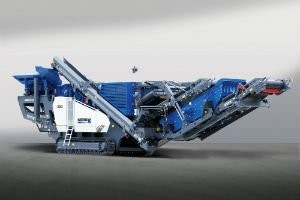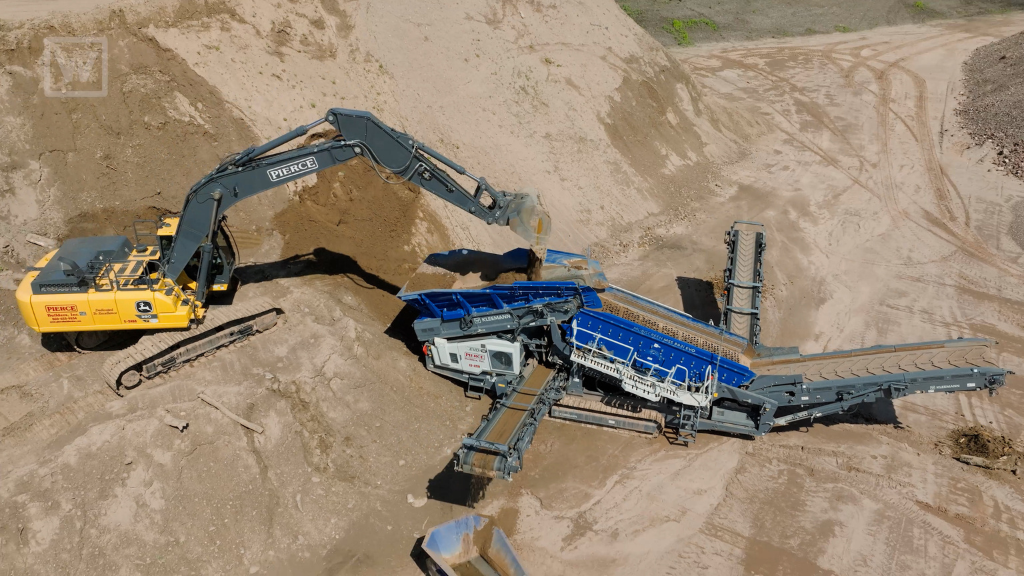
EVO 2 impact crushers represents the continuing evolution of the successful EVO Contractor Line, with additional benefits in terms of economy and operational safety. These new impact crushers are differentiated by their size and productivity; the MR 110 ZSi EVO 2 has a crusher inlet opening of 43.3 in. (1100 mm), and the MR 130 Zi EVO 2 a crusher inlet opening of 51 in. (1300 mm). These provide feed capacities of up to 350 or 450 tph, respectively.
The “S” indicates a Mobirex unit with optional, highly productive secondary vibrating screen with extra-large screening surface mounted on the discharge conveyor. This secondary screen unit can produce spec material, potentially eliminating the need for a separate screen.
The feeding unit has hydraulically folding hopper walls and locking system, which speeds setup. A vibrating double-deck prescreen between hopper and crusher eliminates fines from the product flow before they ever enter the crusher, reducing wear and cutting fuel costs.
Both units are Tier 4 final-compliant. The new EVO 2 Mobirex mobile impact crushers utilize direct drive crushers and electric drives for the vibrating conveyors, belts and the prescreen. This permits high fuel efficiency and allows optimal loading of the crusher.
These crushers feature a new inlet geometry which allows even better penetration of the material into the range of the rotor. Also, the wear behavior of the new C-form impact ledges has been improved to such an extent that the edges remain sharper longer, leading to improved material shape. The rotor ledges are held securely by a new and extremely user-friendly clamping system, which means that they can be changed even quicker, and thus contribute to greater plant uptime.
Outstanding performance is made possible in part by the extremely efficient direct drive, with which the machines are equipped. A latest-generation diesel engine transmits its power almost loss-free directly to the flywheel of the crusher, via a robust fluid coupling and V-belts. This drive concept enables enormous versatility, as the rotor speed can be adjusted in four stages to suit different processing applications.
The Kleemann Continuous Feed System (CFS) manages a more equal loading of the crushing area, in which the conveying frequencies of the feeder trough and the prescreen are adapted independently of each other to the level of the crusher, thus significantly boosting performance.
For the optional S version with secondary screen mounted, the oversize gradation return conveyor has been redesigned from the predecessor models, eliminating a vertical bend and integrating the transfer chute at the feed hopper.
With these new Mobirex impact crushers, the fully hydraulic adjustment capability of the crushing gap permits greater plant uptime, while improving quality of end product.
Not only can the crushing gap be completely adjusted via the touchpanel electronic control unit, but the calculation of the zero-point is possible while the rotor is running. This ability to accurately set the crusher aprons from the control panel with automatic detection of zero point and target value setting saves time, and improves the overall efficiency and handling of the crusher.
In a Kleemann Mobirex impact crusher, zero point is the distance between the ledges of the rotor and the impact plates of the lower impact toggle, plus a defined safety distance. The desired crushing gap is approached from this zero point.
While the upper impact toggle is adjusted via simple hydraulic cylinders, the lower impact toggle has a hydraulic crushing gap adjustment device, which is secured electronically and mechanically against collision with the rotor. The crushing gap is set via the touch screen and approached hydraulically. Prior to setting of the crushing gap, the zero point is determined automatically.
For automatic zero-point determination, with the rotor running, the impact toggle moves slowly onto the rotor ledges until it makes contact, which is detected by a sensor. The impact toggle is then retracted by the defined safety distance. During this procedure, a stop ring slides on the piston rod. When the zero point is reached, the locking chamber is locked hydraulically and the stop ring is fixed in position. The stop ring now serves as a mechanical detent for the piston rod.
During the stop ring check, which is carried out for every crusher restart, the saved zero point is compared with the actual value via the electronic limit switch. If the value deviates, a zero-point determination is carried out once again.
Company info
6030 Dana Way
Antioch, TN
US, 37013
Website:
wirtgen-group.com/en-us
Phone number:
615-501-0600



